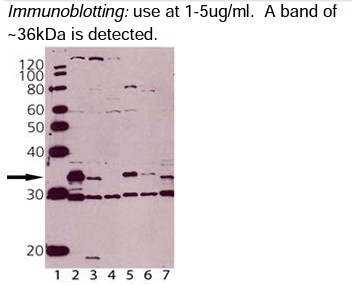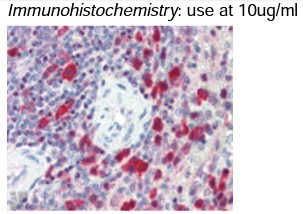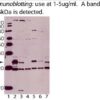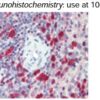Anti-Caspase-3 Antibody (11024-50)
$309.00
| Host | Quantity | Applications | Species Reactivity | Data Sheet | |
|---|---|---|---|---|---|
| Rabbit | 50ug | WB | Human, Mouse, Rat, Rabbit, Chicken, Guinea Pig, Hamster, Monkey, Sheep, Bovine, Canine, Porcine, Yeast |  |
SKU: 11024-50
Categories: Antibody Products, Apoptosis Antibodies, Products
Overview
Product Name Anti-Caspase-3 Antibody (11024-50)
Description Anti-Caspase-3 Antibody Rabbit Polyclonal Antibody
Target Caspase-3
Species Reactivity Human, Mouse, Rat, Rabbit, Chicken, Guinea Pig, Hamster, Monkey, Sheep, Bovine, Canine, Porcine, Yeast
Applications WB
Host Rabbit
Clonality Polyclonal
Immunogen Recombinant full length human caspase-3.
Properties
Form Liquid
Concentration Lot Specific
Formulation PBS, 50% glycerol, 0.09% sodium azide.
Buffer Formulation Phosphate Buffered Saline
Buffer Anti-Microbial 0.09% Sodium Azide
Buffer Cryopreservative 50% Glycerol
Format Purified
Purification Purified by protein A affinity chromatography
Specificity Information
Target Name Caspase-3
Target ID Caspase-3
Uniprot ID P42574
Gene Name CASP3
Gene ID 600636
Sequence Location Cytoplasm.
Biological Function Involved in the activation cascade of caspases responsible for apoptosis execution (PubMed:7596430). At the onset of apoptosis it proteolytically cleaves poly(ADP-ribose) polymerase (PARP) at a '216-Asp-|-Gly-217' bond (PubMed:7774019). Cleaves and activates sterol regulatory element binding proteins (SREBPs) between the basic helix-loop-helix leucine zipper domain and the membrane attachment domain. Cleaves and activates caspase-6, -7 and -9 (PubMed:7596430). Involved in the cleavage of huntingtin (PubMed:8696339). Triggers cell adhesion in sympathetic neurons through RET cleavage (PubMed:21357690). Cleaves and inhibits serine/threonine-protein kinase AKT1 in response to oxidative stress (PubMed:23152800). Acts as an inhibitor of type I interferon production during virus-induced apoptosis by mediating cleavage of antiviral proteins CGAS, IRF3 and MAVS, thereby preventing cytokine overproduction (PubMed:30878284). Cleaves XRCC4 and phospholipid scramblase proteins XKR4, XKR8 and XKR9, leading to promote phosphatidylserine exposure on apoptotic cell surface (PubMed:23845944, PubMed:33725486). {PubMed:21357690, PubMed:23152800, PubMed:23845944, PubMed:30878284, PubMed:33725486, PubMed:7596430, PubMed:7774019, PubMed:8696339}.
Research Areas Apoptosis
Background Caspases are cysteine proteases that cleave after certain aspartate residues and have been identified as mediators of apoptosis. Caspases are synthesized as inactive zymogens that can be cleaved to form active enzymes following the induction of apoptosis by stress or death receptors. Initiator caspases (e.g. caspase-8 and -10) are activated by dimerization of the zymogen on a dedicated adaptor protein. These activated initiator caspases in-turn cleave downstream effector or executioner caspases (e.g. caspase-3, -6, and -7) in a cascade-like manner, which cleave key cellular proteins that lead to the morphological changes associated with apoptotic cell death.
Application Images



Description Detection of caspase-3 in Jurkat cell lysate (lane 2), staurosporine-treated Jurkat cell lysate (lane 3), MCF-7 cell lysate (negative control, lane 4), HeLa cell lysate (lane 5), rat spleen lysate (lane 6), mouse spleen lysate (lane 7).

Description Detection of caspase-3 in human spleen.
Handling
Storage This product is stable for at least one (1) year at -20°C.
Dilution Instructions Dilute in PBS or medium which is identical to that used in the assay system.
Application Instructions Immunoblotting: use at 1-5ug/mL. A band of ~36kDa is detected.
Immunohistochemistry: use at 10ug/mL
These are recommended concentrations.
Endusers should determine optimal concentrations for their applications.
Immunohistochemistry: use at 10ug/mL
These are recommended concentrations.
Endusers should determine optimal concentrations for their applications.
References & Data Sheet
Data Sheet  Download PDF Data Sheet
Download PDF Data Sheet
 Download PDF Data Sheet
Download PDF Data Sheet




